
|
|
Comet
Moon Essays CUSKY Astro Links |
|
Maintained by
suitti@uitti.net,
Stephen Uitti |
A talk presented at the Warren Astronomical Society on 21 October 2004. Forward
Why do many now view science as a failed ideology rather than as an epistemological ideal?
Can science be shown to be a superior means of acquiring knowledge? Yes it can, but only by showing that it is more likely to yield justified beliefs than any other methodology. Thus the real issue is not whether a belief is scientific or pseudoscientific but whether it is justified or unjustified.
We are justified in believing something to be true when it provides the best explanation of the evidence. Science is superior to other methods of inquiry because it usually provides better explanations than they do. The goodness of an explanation is determined by the amount of understanding it produces, and the amount of understanding an explanation produces is determined by how much it systematizes and unifies our knowledge. The extent to which an explanation does this can be determined by appealing to various criteria of adequacy such as simplicity, scope, conservatism, and fruitfulness. No one wants to hold unjustified beliefs. The problem is that most people never learn the difference between a good explanation and a bad one. Consequently they come to believe all sorts of weird things for no good reason.
Scientists and educators alike need to realize that the educated person is not the person who can answer the questions, but the person who can question the answers. In our age of rapidly changing information, knowing how to distinguish truth from falsity is more important than knowing what was once considered true and false. Only a person who knows the difference between a justified and an unjustified belief can truly appreciate the value of scientific inquiry.
-- Theodore Schick Jr.
The book, Curiosities of the Sky was written by Garrett Serviss and was first published in 1909.
The text of the book is available for free at the Project Gutenberg web site.
http://www.gutenberg.net/browse/BIBREC/BR6630.HTM
The idea of the author was to describe then-modern astronomy to the layman. Most of the concepts had only been discussed in technical forums and papers. Many of these concepts were cutting edge at the time, so mistaken theories are exposed.
Modern versions of this book would be Sagan's Cosmos and various cable TV series, such as the recent Origins series, specializing in narrower topics. Excellent examples are the Nova series The Planets, and the Alex Filippenko series, Understanding the Universe, both available in the WAS library.
Audio
There is a free program on the internet called festival which can convert text files into audio speach. Also, there is a program notlame to convert this audio into MP3 format. I burned the result onto a CD. I then played this on my car stereo. The book requires about 5 hours and 20 minutes. This may sound like alot, but I have an hour commute to work, each way, every day.
The spoken text takes some getting used to. It mispronounces some words that are not in its lexicon, and sometimes has strange emphasis. It reads pretty well given that it really does not have any clue what it is reading.
[brief audio example].
Thus the more we see of the universe with improved methods of observation, and the more we invent aids to human senses, each enabling us to penetrate a little deeper into the unseen, the greater becomes the mystery. The telescope carried us far, photography is carrying us still farther; but what as yet unimagined instrument will take us to the bottom, the top, and the end? And then, what hitherto untried power of thought will enable us to comprehend the meaning of it all?
Though alot has happend in nearly 100 years in Astronomy, much of what was known in 1909 is still considered correct. I thought it might be fun to go over some of the things that were right, and wrong. Yet, the real value of the book is that it describes in detail, the thought processes used to obtain the conclusions that were reached concerning a dozen hot mysteries of the day. My hope is that this can teach us how to interpret modern discoveries.
Misc
Terminology has changed since 1909. Some fundamental ideas color the language used. For example, the term Universe is mostly synonymous with the Milky Way Galaxy. In the book, there is speculation that there may be others. However, M31 is called the great Andromeda nebula. It is classed as the same kind of object as the Great Orion Nebula.
Ether is thought to be required for light transmission. Light has wave behaviour. Waves require a medium for transmission. Ether and gravity are thought to be probably everywhere. This is another way of saying that it is assumed that physical laws on Earth are the same as elsewhere.
Some current day theories are ignored or unknown:
Michaelson and Morley had conducted an experiment in 1887 that disproved the existence of ether. Experiments continued trying to detect the ether until at least 1925. In 1905, Einstein declared that ether was not needed.
They laughed at Einstein. They laughed at the Wright Brothers. But they also laughed at Bozo the Clown.
-- Carl Sagan
The mystery of coal sacks
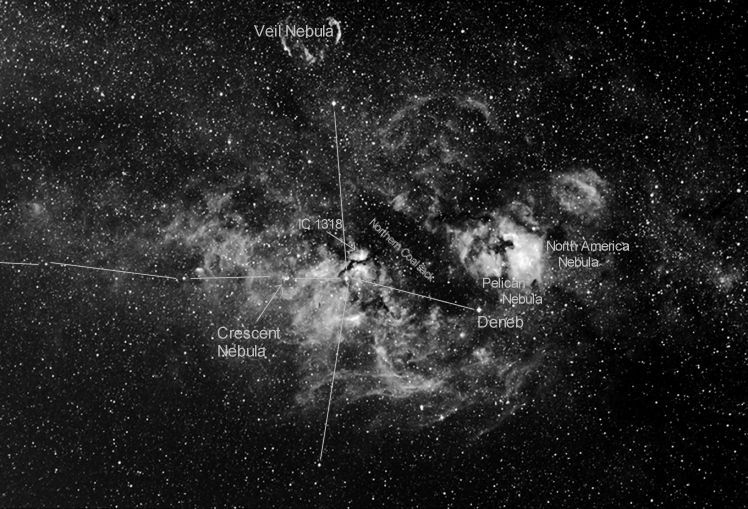
See Coal Sack
Telescopes of the day could not detect any light. So, what are they?
After listing several coal sacks, including one visible in the Northern Hemisphere, the author offers these theories:
- They appear like holes in the sky. What if they are windows to extreme distances - other Universes. A big enough telescope might be able to see another Universe. Would a huge runaway sun, like Arcturus, for instance, make such an opening if it should pass like a projectile through the Milky Way?
- Or perhaps they are immense collections of shadowy gases and meteoric dust whose presence is only manifested when they intercept the light coming from shining bodies behind them.
The Milky Way

The Milky Way (the universe) contains a hundred million suns.
Stars in the Milky Way are not less than ten thousand light-years away.
Is the Milky Way round in section like a rope, or flat and thin like a ribbon?
The Milky Way's shape is a flat round disk filled with stars.
The Milky Way's shape is a flat round disk, filled with stars, our sun and relatively few neighbors are placed near the center. (There seems to be a break between the "nearby" visible stars and those that are indistinguishable and form the glow. The idea that bigger scopes always see more stars than smaller ones did not seem to occur to anyone.)
This flat star-cluster is moving edgewise through the chaos, and it acts after the manner of a snow plow sweeping away the cosmic dust and piling it on either hand above and below the plane of the moving cluster. (This accounts for a big sparse area and knots in the Milky Way).
The Milky Way is a ring of distant stars, the central opening contains many scattered stars, and is many times broader than the width of the ring itself. Our sun is one of the scattered stars in the central opening. (This despite references to the dethroning of the earth as at the center.)
Speculation on what another galaxy might look like: spherical like a globular, flat ring, as the Milky Way appears. This is very strange, since galaxies are called nebula, and are thought to be inside the Milky Way.
Stellar Migrations Of Nearby Stars
Proper motion movement measurements are limited to nearby stars. Radial motion is limited to reasonably bright stars. Spectrographic radial speeds sometimes oscillate - indicating orbit, adding difficulty to measurements.
Stars are not "fixed". Proper motion suggests constellation changes.
The stars move in every conceivable direction and have no apparent center of motion.
Example, 1830 Groombridge, which appears to be moving fast enough to leave the Milky Way, at perhaps 400 miles per second. Also Arcturus, at perhaps 200 miles per second. (What is the escape velocity of the Milky Way?).
Geologists require 200 million to 1 billion years for evolution. In that time, the Sun would have traveled farther than the farthest distance in the Milky Way.
Warm geological ages may have been due to the solar system traversing a "warm region of space".
The Pleiades. All of the principle stars composing that group are traveling in virtually parallel lines.
Five of the seven stars constituting the figure of the "Great Dipper" are moving parallel.
Members of compact star clusters share speed and direction of motion through space.
Of 1100 nearby stars, there are two "streams", moving in nearly opposite directions, near Orion and Ara (near Scorpio).
There is a loop of Milky Way light encircling Orion (no mention of a connection with the above stream concept).
Star-Clouds, Star-Clusters
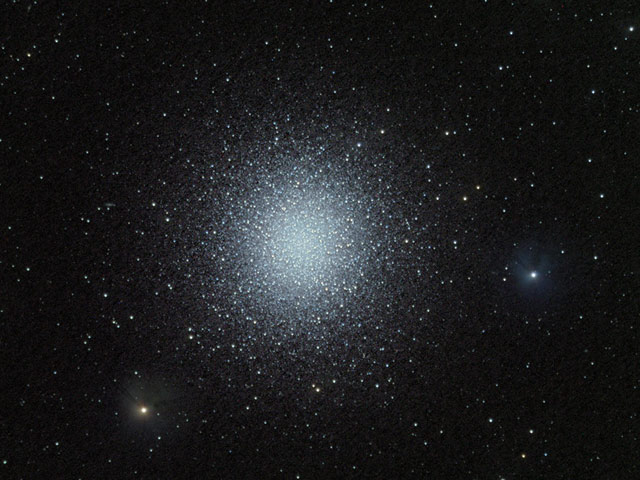
See M13
The Great Cluster in Hercules is estimated about fourteen thousand suns.
It takes the form of a hollow hemisphere.
It may be the result of explosion.
It is forty-five thousand miles in diameter -- something more than half the diameter of the planet Jupiter. (Aren't the suns bigger than that?)
It is produced by the coagulation of a great nebula into stellar nuclei, a process now taking place in the Orion Nebula.
On the other hand, an explosion due to chance of collisions must be considered.
The Pleiades lies outside the main course of the Galaxy, but is connected with it by a faint loop.
The Pleiades has faint nebulous masses, further along star forming than Orion nebula, perhaps due to less remaining material.
Super Nova
An explosion, such as stripping off the shell of an encrusted sun or
the crashing together of two mighty orbs flying through space.
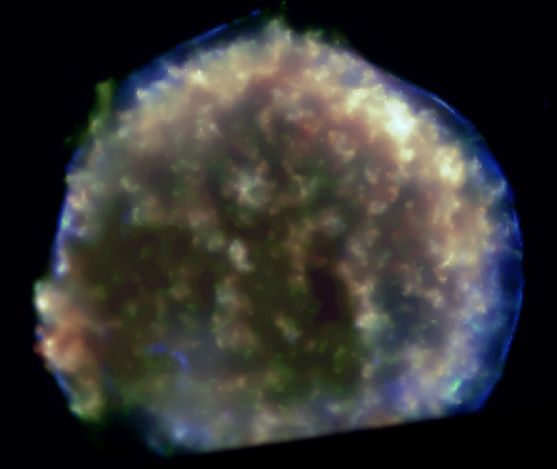
See Tycho's Star
There was one in 1572, and is known as Tycho's Star, position known. As bright as Venus. Visible in full daylight.
(no mention of Kepler's 1604 SN.)
SN 1866, 2nd magnitude in Northern Crown, Huggins used spectroscope, the new star consisted largely of incandescent hydrogen. However, a 9th magnitude star was there before.
Andromeda Nebula
In 1885, astronomers were surprised to see a sixth-magnitude star glimmering in the midst of the hazy cloud of the great Andromeda Nebula. It soon absolutely disappeared. Its spectrum was remarkable for being continuous, like that of the nebula itself. A continuous spectrum is supposed to represent a body, or a mass, which is either solid or liquid, or composed of gas under great pressure.
In other words, they thought that M31 was a nebula, despite
spectrographic evidence to the contrary. Then, a faint supernova
appears there, at least 9 magnitudes fainter than usual, indicating a
factor of 4,000 reduced brightness, suggesting that the object is at
least 60 times further away. Perhaps, since they have really no idea
how far away the bright ones are, this has no significance for them.
It should have told them that M31 must be 60 times farther than other
nova. If the bright supernova are at least 10,000 light years away
(in the band of the Milky Way), then M31 ought to be at least 600,000
light years away, quite outside of the Milky Way. But this deduction
didn't happen. Note that they thought that nova are stellar
explosions. Further, they were known to brighten by 7 magnitudes or
more. This should indicate that these nova are pretty far away.
Perhaps this is what Hubble was thinking some 15 years later, but
wanted better proof.
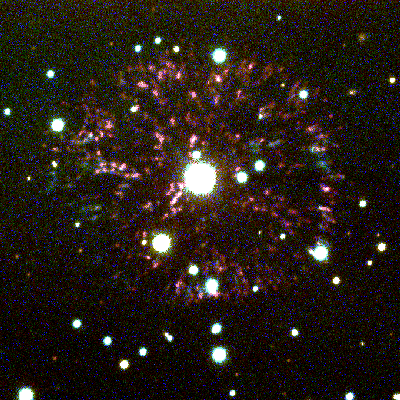
See Nova
In 1901, a pre-maximum sighting of a nova was reported. Pictures days before showed that no star down to 12th magnitude existed. Then, the nova appears, and for two days brightens to maximum. Then, in jerks, it fades over time. Finally, pictures were taken and the nova was surrounded by a nebula - which they did not see before. The spectrum transforms from stellar to nebular over 6 months. The speculation is that two stars collided.
During the collision: the photospheric envelope of the star is destroyed, the internal incandescent mass gushes out.
The theories of what causes nova include collision of two stars, collision of a star and a nebula, chemical change in a star (including oxygen/hydrogen), and atomic explosion.
One theory is that most or all stars nova, but the ones we see are short lived stars. Most stars take "millions of years" to get to this point.
Explosive and Whirling Nebulae
The great majority of the nebulae have a distinctly spiral form.
This likely led to the confusion of nebula and galaxies.
The hypothesis of Laplace: the solar system formed from a rotating and contracting nebula.
Nebula come in two spectral classes. Continuous spectra indicate that the mass from which the light comes is either solid or liquid, or a gas under heavy pressure. The Andromeda Nebula is of this type. Then there those with spectra that are distinctly gaseous. The Orion Nebula is of this type.
but then...
The spectrum of the Andromeda Nebula has been interpreted to mean that it consists not of luminous gas, but of a flock of stars so distant that they are separately indistinguishable even with powerful telescopes, just as the component stars of the Milky Way are indistinguishable with the naked eye; and upon this has been based the suggestion that what we see in Andromeda is an outer universe whose stars form a series of elliptical garlands surrounding a central mass of amazing richness. But this idea is unacceptable if for no other reason than that, as just said, all the spiral nebulae possess the same kind of spectrum, and probably no one would be disposed to regard them all as outer universes. As we shall see later, the peculiarity of the spectra of the spiral nebulae is appealed to in support of a modern substitute for Laplace's hypothesis.
The Orion Nebula appears to be the birthplace of a swarm of stars. This swarm of stars will remain gravitationally bound. This is a tie in to globular clusters...
The Banners of the Sun
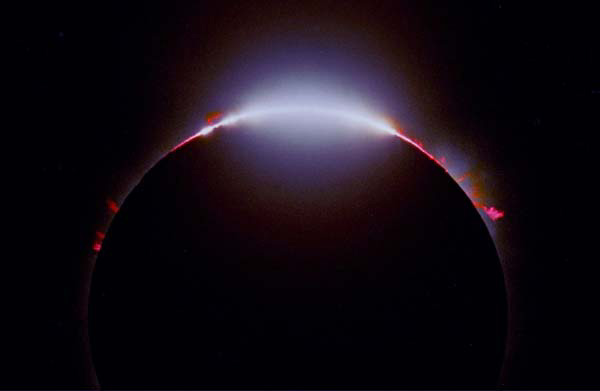
See The Sun
Much of what is known about the Sun is due to eclipse by the moon. The corona, and prominences were first seen this way. In 1842, Janssen used spectoscopy to study prominces without an eclipse.
There are two kinds of prominences, "erruptive" and "quiescent".
Erruptive may only appear where sun-spots congregate. They shoot out. It is evident that some of the matter hurled forth in eruptive prominences may escape from solar control.
Quiescent are cloud like, and may appear anywhere.
Professor Hale has proved that sun-spots are strong magnetic fields.
It has been suggested that sun-spots are indications of the beginning of a process in the sun which will be intensified until it falls into the state of such a star as Mira. Stars very far advanced in evolution, without showing variability, also exhibit similar spectra; so that there is much reason for regarding sunspots as emblems of advancing age.
Since the development of the curious subject of the "pressure of light" it has been proposed to account for the sustentation of the corona by supposing that it is borne upon the billows of light continually poured out from the sun.
Sometimes a solar outburst is followed by cable and telegraph systems disturbance. Messages are abruptly cut off, sparks leap from the telegraph instruments, etc.
Since 1843, the sun spot cycle is known. Variable, averaging 11 years, during which the number of spots visible on the sun first increases to a maximum, then diminishes to a minimum, and finally increases again to a maximum. The phenomena always recur in the same order.
When a new period opens, the spots appear first in high northern and southern latitudes, far from the solar equator, and as the period advances they not only increase in number and size, but break out nearer and nearer to the equator, the last spots of a vanishing period sometimes lingering in the equatorial region after the advance-guard of its successor has made its appearance in the high latitudes.
Spots are never seen on the equator nor near the poles.
A large number of sun spots coincides with Earth magnetic variations.
The corona, as we have said, varies with the sun-spot cycle.
The Zodiacal Light Mystery
In dark skies, with no moon, soon after sunset in February, the "ghostly presence" rises from where the Sun goes down, and brightens, forming the shape of an elongated pyramid of pearly light, leaning toward the south if the place of observation is in the northern hemisphere. It is brightest near the horizon, gradually fading as the pyramidal beam mounts higher, but in favorable circumstances it may be traced nearly to the meridian south of the zenith, where its apex at last vanishes in the starlight. Also, March, and part of April. Also Autumn - September, October.
The Rev. Mr Jones, saw it from many latitudes on both sides of the equator. On his return he attempted to show that the phenomenon was due to the reflection of sunlight from a ring of meteoric bodies encircling the earth.
The Zodiacal Light is an appendage of the sun, an extension of the corona in the plane of the ecliptic. If the substance of the corona could extend ten million miles from the sun, perhaps it extends one hundred million. (However observational evidence does not support this. The extension of the corona in 1878 did not resemble in its texture the Zodiacal Light.)
Alternately, the reflection is due to swarms of meteors circling about the sun, in the plane of its equator, all the way from its immediate neighborhood to a distance exceeding that of the earth.
Ions emitted from the Sun pick up other atoms. They are pushed from the Sun by light pressure. If we were on the moon, we'd see a comet like tail extending from the Earth. All planets with an atmosphere ought to have Zodiacal Light, though it's too faint to see, for example, Venus's comet tail.
Aurora
The focus of the displays is the magnetic pole, north or south.
Accompanied by telegraph disruptions.
It was discovered that it is a phenomenon intimately associated with disturbances on the sun - sun spots.
The Arrhenius hypothesis of negative corpuscles, or ions, driven away from the sun by light-pressure is the way in which the sun creates the Aurora. Obeying a law which has been demonstrated in the laboratory, the particles then follow the lines of force toward the poles. While they are above the equatorial regions they do not become luminescent, because at the great elevation that they there occupy there is virtually no atmosphere. When they pass toward the poles they begin to descend with the lines of force, curving down to meet the Earth, encountering a part of the atmosphere, they produce a glow of cathode rays. This glow is conceived to represent the Aurora.
It has been observed that there are more in March and September than at any other time of the year. The earth is directly over the solar equator twice a year, in March and September. As things stand the Earth is never directly over the most active regions of the sun-spots, and consequently never suffers from the maximum bombardment of charged particles of which the sun is capable.
The formation of clouds in the upper air is more frequent in years when aurorae are most abundant, because clouds are the result of the condensation of moisture upon floating particles in the atmosphere.
Aurorae are reduced on the side of the Earth that has the moon. It is suggested that the moon is negatively charged, due to ions from the Sun.
Comets
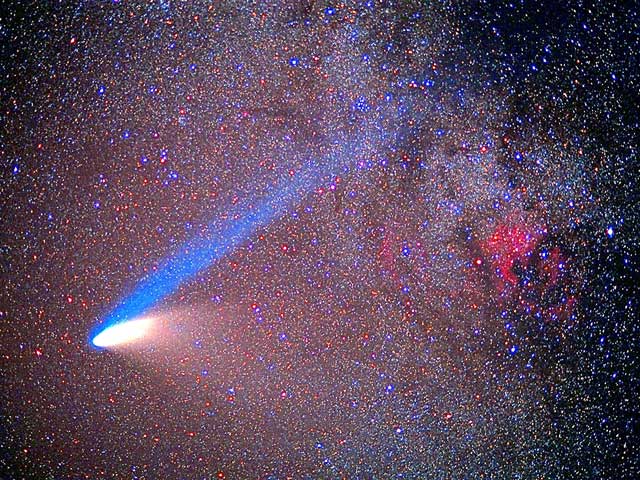
See Comet
Comets follow apparent parabolic or hyperbolic orbits. However, these may be elipses.
The Sun may pick up cometary masses on it's journey.
The tail streams from the body of the comet due to the Sun. The tail streams away from the Sun. Comet tails may stretch 100 million miles in length.
The diameter of the nucleus may vary from a few hundred up to several thousand miles. The heads are typically from twenty-five thousand to one hundred thousand miles in diameter, but the largest are up to a million and a quarter miles in diameter!
Smaller jets appear on the Sun side, arcing away from the Sun.
The nucleus appears to rotate.
Sometimes the nucleus is seen to break up into several parts.
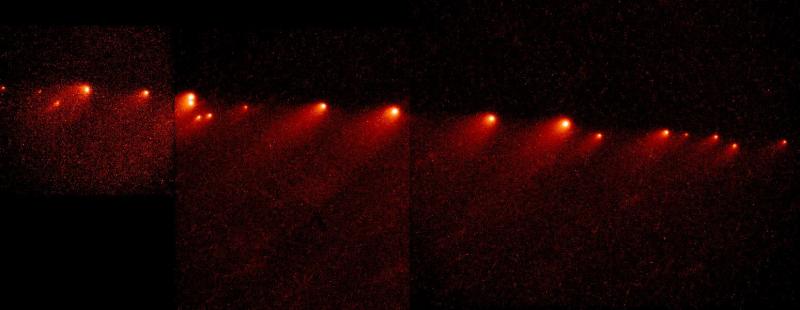
See SL9
Spectroscopy has yielded chemical composition. hydro-carbon compounds, sodium and iron. Not all spectral lines are identifiable.
Professor Barnard's photographs of Brooks' comet in 1893 suggested, by the extraordinary changes in the form of the tail which they revealed, that the comet was encountering a series of obstructions in space which bent and twisted its tail into fantastic shapes.
The great planets, and especially Jupiter, frequently interfere with the motions of comets. This interference is not limited to the original alteration of their orbits from possible parabolas to ellipses, but is sometimes exercised again and again, turning the bewildered comets into elliptical paths of all degrees of eccentricity.
Then there is the strange fate of one member of Jupiter's family, Biela's comet, which, having become over bold in its advances to its captor, was, after a few revolutions in is impressed orbit, torn to pieces and turned into a flock of meteors.
The Arrhenius theory of light pressure moves comet tails away from the sun.
As a comet approaches the sun eruptions of vapor, due to the solar heat, occur in its nucleus. These are naturally most active on the side which is directly exposed to the sun, whence the appearance of the immense glowing envelopes that surround the nucleus on the sunward side.
At the same time we have an explanation of the multiple tails with which some comets have adorned themselves. The comet of 1744, for instance, had at one time no less than seven tails spread in a wide curved brush behind it. This has to do with the mass of the particles. Low mass particles are pushed straight back, where more massive particles form an arc.
Meteors, Fire-Balls, and Meteorites
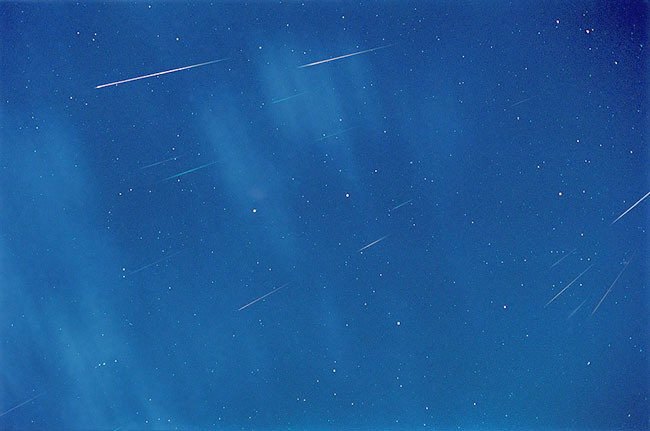
Leonids
The Leonids were particularly dense in 1833. Professor Denison Olmsted of Yale College suggested a stream of meteors - that might appear like a diffuse comet. Later there were recognized as cometary debris. The period of the debris orbits was found to be 33.25 years. A dense storm was predicted for 1866. 1867 was also good.
Schiaparelli showed that the Persieds (August) were also cometary in nature.
The annual periodicity of the August meteors was ascribed to the fact that the separation had taken place so long ago that the meteors had become distributed all around the orbit, in consequence of which the earth encountered some of them every year when it arrived at the crossing-point.
The November meteors should have exhibited another pair of spectacles in 1899 and 1900, and their failure to do so caused at first much disappointment, until it was made plain that a good reason existed for their absence. It was found that after their last appearance, in 1867, they had been disturbed in their movements by the planets Jupiter and Saturn, whose attractions had so shifted the position of their orbit that it no longer intersected that of the earth, as it did before.
In 1826 Biela, of Josephstadt, Austria, discovered a comet to which his name was given. On one of its returns, in 1846, it astonished its watchers by suddenly splitting in two. They returned further seperated. Later, they did not return, but instead, there was a meteor shower. A small cometary mass was detected. In 1885, a meteor fell at Mazapil, Mexico. The recovered piece was brought to the Museum in Vienna, and is thought to be part of Biela.
Lord Kelvin suggested that the first germs of life may have been brought to the earth by one of these bodies, a fragment of an exploded world.
In 1803, a veritable shower of falling stones occurred at L'Aigle, in Northern France, and this time astronomers took note of the phenomenon and scientifically investigated it.
Their velocity before entering the earth's atmosphere is equal to that of the planets in their orbits -- viz., from twenty to thirty miles per second.
They generally appear at an elevation of eighty or a hundred miles, and are seldom visible after having descended to within five miles of the ground, unless the observer happens to be near the striking-point, when he may actually witness the fall. Frequently they burst while high in the air and their fragments are scattered like shrapnel over the surface of the ground, sometimes covering an area of several square miles.
Meteorites are of two kinds: stony meteorites and iron meteorites. Twenty stony for every iron. Twenty-five chemical elements have been found in meteorites, including carbon and helium, iron, nickel, oxygen, platinum. In some cases the carbon has become diamond!
A meteorite weighing many tons and striking the earth with a velocity of twenty or thirty miles per second, would probably cause frightful havoc. An event of this kind actually happened in North America -- perhaps not longer than a thousand or two thousand years ago, in northern central Arizona. The crater is somewhat over four thousand feet in diameter, and the surrounding rim, formed of upturned strata and ejected rock fragments, rises at its highest point one hundred and sixty feet above the plain. The crater is about six hundred feet in depth -- that is, from the rim to the visible floor or bottom of the crater. Some ten tons have been recovered for sale to the various collectors throughout the world. Debris is scattered to about 5 miles. Material of unmistakably meteoric origin was found by means of the drills, mixed with crushed rock, to a depth of six hundred to seven hundred feet below the floor of the crater. Mr Tilghman has estimated that a meteorite about five hundred feet in diameter and moving with a velocity of about five miles per second would have made just such a perforation upon striking rocks of the character of those found at this place.
Meteorites are the only celestial phenomena attended with perceptible sounds.
Professor Pickering conjectures that this supposed flock of great meteorites may have formed the nucleus of a comet which struck the earth.
The Moon
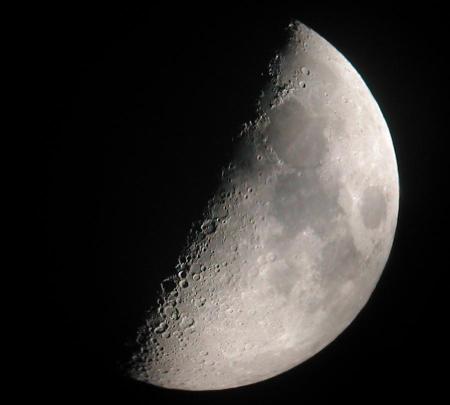
The moon - the child of our mother earth.
Telescopes will be capable of 5000x, as they improve.
One might communicate with Mars or the moon via wireless (radio).
Darwin's hypothesis is that the moon was separated from the earth by tidal action while both were yet plastic or nebulous.
Tycho appears as a perfect ring surrounding a circular depression, in the center of which rises a group of mountains. Its superficial resemblance to some terrestrial volcanic craters is very striking.
The remains of the outer crater ring of Vesuvius are perhaps half a mile in diameter. Tycho has a diameter of fifty-four miles.
The lunar craters differ from those of the earth. They are not situated on the tops of mountains.
There are many things about the craters which seem to give some warrant for the hypothesis which has been particularly urged by Mr G. K. Gilbert, that they were formed by the impact of meteors; but there are also many things which militate against that idea, and, upon the whole, the volcanic theory of their origin is to be preferred.
Escape velocity for the Earth is 7.5 miles/sec. For the moon, it is 1.5 miles/sec. This heights can be higher.
Some of the meteorites that have fallen upon the earth originated from the lunar volcanoes.
The moon does not contain much iron.
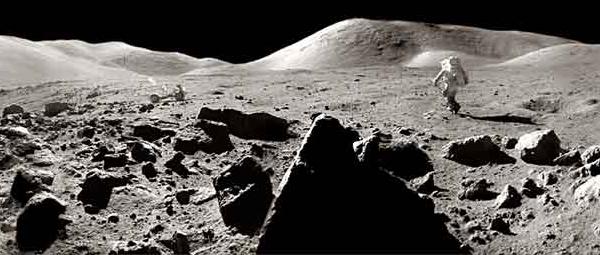
Moon Geologist
What geologist would not wish to try his hammer on those rocks with their stony pages of fossilized history?
If we could visit the moon, there is not among us a person so prosaic and unimaginative that he would not, the very first thing, begin to search for traces of its inhabitants.
The so-called sea bottoms are really vast plains of frozen lava which gushed up in floods so extensive that even the mighty volcanoes were half drowned in the fiery sea.
Messrs. Loewy and Puiseux, the selenographers of the Paris Observatory, are convinced that these great plains bear characteristic marks of the former presence of immense bodies of water.
The little planet Mercury, which also has parted with its air and water, is pitted with craters resembling those that have torn to pieces the face of the moon.
Mars
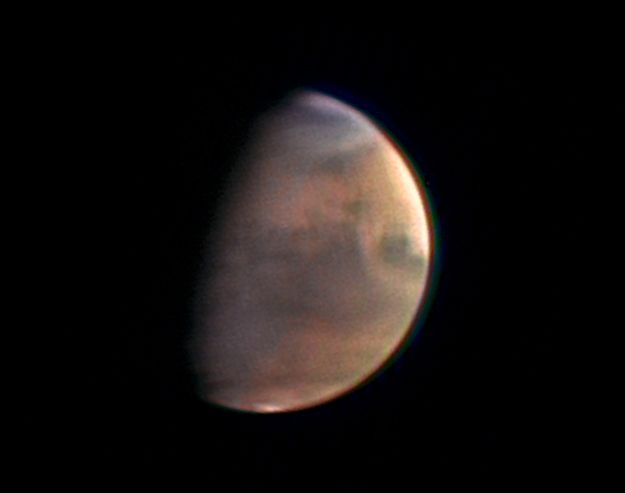
Mars
The universe is everywhere filled with life.
The astronomical view of the universe is that it consists of matter in every stage of evolution: some nebulous and chaotic; some just condensing into stars (suns) of every magnitude and order; some shaped into finished solar bodies surrounded by dependent planets; some forming stars that perhaps have no planets, and will have none; some constituting suns that are already aging, and will soon lose their radiant energy and disappear; and some aggregated into masses that long ago became inert, cold, and rayless, and that can only be revivified by means about which we can form conjectures, but of which we actually know nothing.
While it is tacitly assumed that there are planets revolving around other stars than the sun, it would be impossible for us to see them with any telescope yet invented, and no instrument now in the possession of astronomers could assure us of their existence; so the only planetary system of which we have visual knowledge is our own.
The solar system has eight planets of various sizes and situated at various distances from the sun.
Of these eight we know that one, the earth, is inhabited. The question, then, arises: Are there any of the others which are inhabited or habitable?
Mercury always keeps the same face toward the sun.
Venus, the next in distance from the sun, is almost the exact twin of the earth in size, and many arguments may be urged in favor of its habitability, although it is suspected of possessing the same peculiarity as Mercury, in always keeping the same side sunward. Unfortunately its atmosphere appears to be so dense that no permanent markings on its surface are certainly visible, and the question of its actual condition must, for the present, be left in abeyance.
Mars receives less than half as much solar light than Earth gets.
The surface of Mars is solid, like Earth.
There is watery vapor in the Mars atmosphere.
Mars has no mountain ranges. No evidences of volcanic action have been discovered on Mars.
It is not believed that there are any bodies of water on the planet. There has never been much doubt expressed that the white areas about the poles represent snow.
The first champion of the habitability of Mars was Sir William Herschel.
Schiaparelli perceived that the reddish areas, then called continents, were crossed in many directions by narrow, dusky lines, to which he gave the suggestive name of ``canals.''
The ``canals'' made their appearance after the melting of the polar snow in the corresponding hemisphere had begun, and that they grew darker, longer, and more numerous in proportion as the polar liquidation proceeded; another very puzzling observation was that many of them became double as the season advanced; close beside an already existing ``canal,'' and in perfect parallelism with it,
Mr Percival Lowell took up the work where Schiaparelli had virtually dropped it, and soon added a great number of ``canals'' to those previously known, so that in his charts the surface of the wonderful little planet appears covered as with a spider's web.
Mars has parted with its internal heat more rapidly than the earth. As the globe of Mars is evolutionally older than that of the earth, so its forms of organic life may be proportionally further advanced, and its inhabitants may have attained a degree of cultivated intelligence much superior to what at present exists upon the earth.
The narrow streaks that we see are not the canals themselves, but the irrigated bands covered by them.
If we wish to let the imagination loose, we may conjecture that they have conquered the secret of those intra-atomic forces - thus powering the canal pumps.
Asteroids
600 known. They may actually number thousands.
The most striking general fact about them is that they occupy the place in the sky which should be occupied, according to Bode's Law, by a single large planet. This fact, as we shall see, has led to the invention of one of the most extraordinary theories in astronomy -- viz., that of the explosion of a world!
Bode's Law, so-called, is only an empiric formula, but until the discovery of Neptune it accorded so well with the distances of the planets that astronomers were disposed to look upon it as really representing some underlying principle of planetary distribution.
In 1801, Piazzi, of Palermo, announced that he had found a little planet which apparently occupied the place in the system which belonged to the missing body. He named it Ceres.
The first four are by far the largest members of the group, but their actual sizes remained unknown until less than twenty years ago.
It has even been conjectured that the two tiny moons of Mars and the
four smaller satellites of Jupiter may be asteroids gone astray and
captured by those planets.
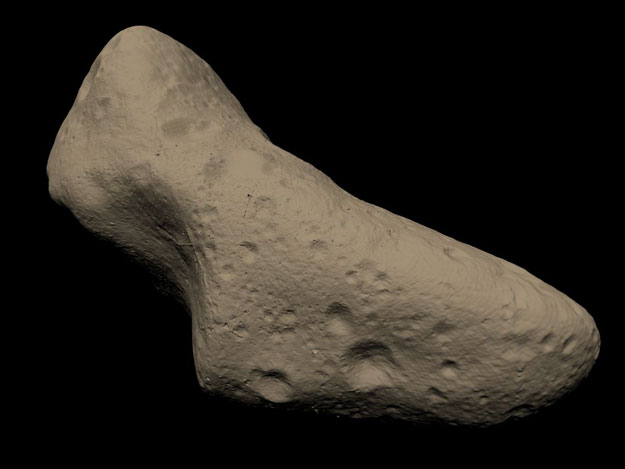
See eros
Eros was discovered in 1898. The mean distance of Eros is less than that of Mars. The orbit of Eros is so eccentric that at times it approaches within 15,000,000 miles of the earth, nearer than any other regular member of the solar system except the moon, thus affording an unrivaled means of measuring the solar parallax. But for our present purpose the chief interest of Eros lies in its extraordinary changes of light. Von Oppolzer found, in 1901, that Eros lost three-fourths of its brilliancy once in every two hours and thirty-eight minutes. The most interesting interpretation that has been offered of this phenomenon is that it is due to a great irregularity of figure. Eros has a form not unlike that of a dumb-bell, or hour-glass, turning rapidly end over end so that the area of illuminated surface presented to our eyes continually changes, reaching at certain times a minimum when the amount of light that it reflects toward the earth is reduced to a quarter of its maximum value. Various other bizarre shapes have been ascribed to Eros, such, for instance, as that of a flat stone revolving about one of its longer axes, so that sometimes we see its face and sometimes its edge. It is a fragment, for it seems impossible to believe that a body formed in interplanetary space, either through nebular condensation or through the aggregation of particles drawn together by their mutual attractions, should not be practically spherical in shape.
Even Vesta was regarded by Olbers as sufficiently variable in its light to warrant the conclusion that it was an angular mass instead of a globe.
The asteroids were formed out of a relatively scant ring of matter. The attraction of the giant Jupiter was sufficient to prevent the small, nebulous ring that gave birth to the asteroids from condensing like the others into a single planet.
(On the theory of an explosion for the asteroids:) Dr Gustav Le Bon suggests atomic explosion, based on his theory of the dissipation of intra-atomic energy. Basically radioactive decay of atom signifies old age for atoms. Perhaps all atoms will one day decay explosively.
The energy produced by the breaking down of the atom is a very poor kind of thing. Anyone who expects a source of power from the transformation of these atoms is talking moonshine.
-- Ernest Rutherford, after he had split the atom for the first time